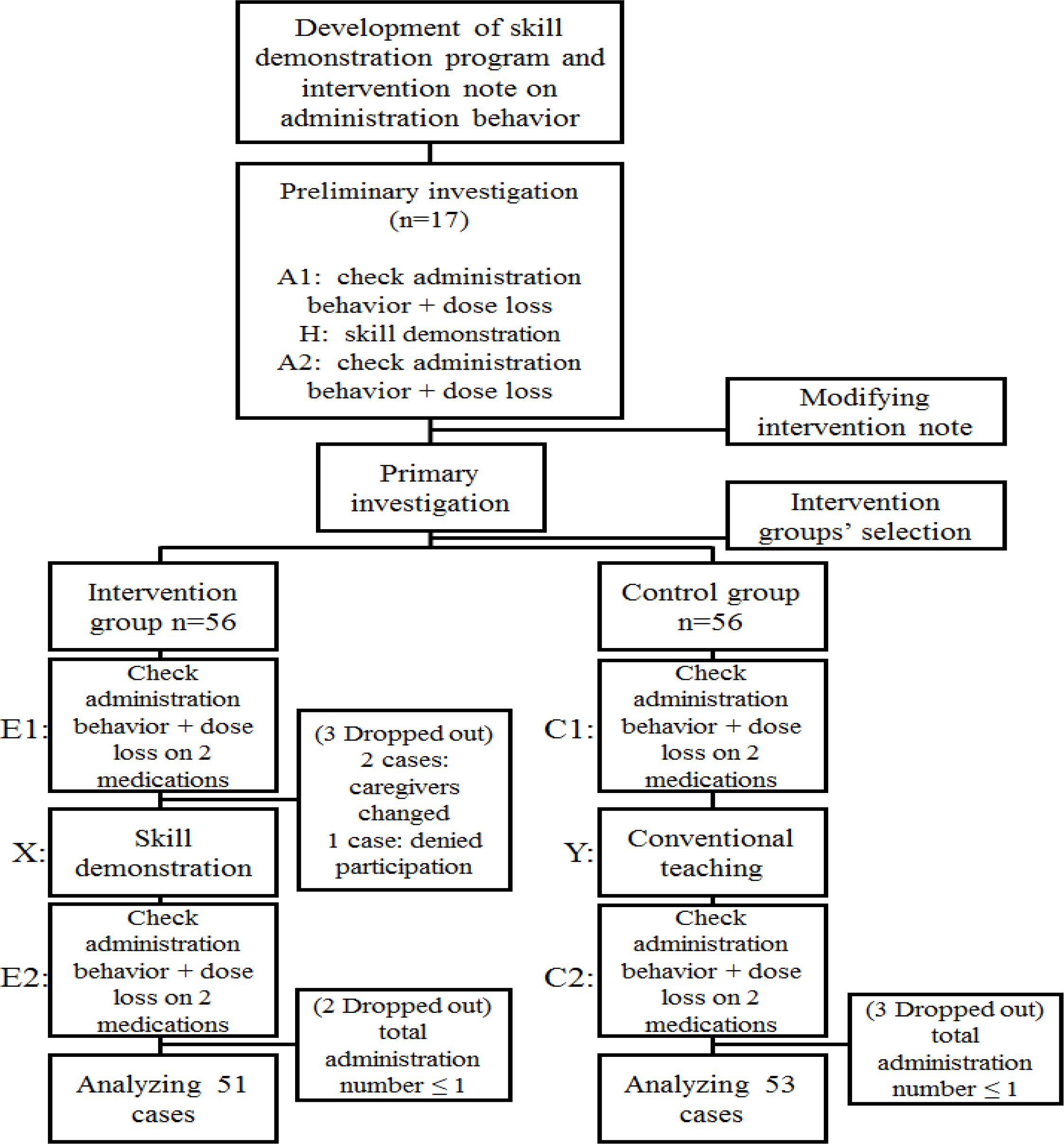Korean J Adult Nurs.
2017 Aug;29(4):333-342. 10.7475/kjan.2017.29.4.333.
Effects of Skill Teaching of Oral Administration for Caregivers of Hospitalized Toddler on Dose Loss and Administration Behavior
- Affiliations
-
- 1Dongguk University Ilsan Hospital, Ilsan, Korea.
- 2College of Nursing, Korea University, Seoul, Korea. nshin@korea.ac.kr
- KMID: 2406361
- DOI: http://doi.org/10.7475/kjan.2017.29.4.333
Abstract
- PURPOSE
This study was designed to assess the effects of skill teaching of oral liquid medication on the dose loss and caregivers' administering behavior.
METHODS
A nonequivalent control group no-synchronized design was used. 104 participants were assigned to one of two groups. A intervention group received a skill teaching and the control group received the conventional teaching about oral medication.
RESULTS
The mean amount of the dose loss by all participating caregivers was 23.3% of the prescribed dose and 61.5% of the caregivers showed dose loss more than 20% of the prescribed dose. Caregivers' age (Exp=3.56, p=.017) and time taken for administration (Exp=7.97, p < .001) were related to more dose loss. Toddlers' posture sitting in a stroller upon medication (Exp=.14, p=.009) and re-administering the remains after checking the medication bottle (Exp=.22, p=.040) influenced on reduction in dose loss. Before and after the skill teaching, a significant decrease in the dose loss was found in the high-viscous liquid medication only (t=−4.95, p < .001). The difference in the dose loss between the two groups were significant in the high-viscous liquid medication (t=4.95, p < .001). Also, caregivers' administration behavior were significantly improved in the intervention group.
CONCLUSION
The findings of this study showed that the skill teaching of oral liquid medication designed for toddlers' caregivers was effective in reduction of dose loss and improvement in administering behaviors with confidence.
Figure
Reference
-
1. Hockenberry MJ, Wilson D. Wong's essentials of pediatric nursing. 3th. ed.Jo KJ, Song JH, You IY, Park IS, Park ES, Kim MW, editors. translator.USA: Elsevier Science Health Science div;2012. p. 511.2. Lajoinie A, Henin E, Kassai B. Oral formulation of choice for children. Archives de pediatrie: Organe Officiel de la Societe Francaise de Pediatrie. 2015; 22(8):877–85. https://doi.org/10.1016/j.arcped.2015.05.012.3. Madlom-Kay DJ, Mosch FS. Liquid medication dosing errors. Journal of Family Practice. 2000; 49(8):741–4.4. Sobhani P, Christopherson J, Ambrose PJ, Corelli RL. Accuracy of oral liquid measuring devices: comparison of dosing cup and oral dosing syringe. Annals of Pharmacotherapy. 2008; 42(1):46–52. https://doi.org/10.1345/aph.1K420.
Article5. Peacock G, Parnapy S, Raynor S, Wetmore S. Accuracy and precision of manufacturer -supplied liquid medication administration devices before and after patient education. Journal of the American Pharmacists Association. 2010; 50(1):84–6.6. Ryu GS, Lee YJ. Analysis of liquid medication dose errors made by patients and caregivers using alternative measuring devices. Journal of Managed Care & Speciality Pharmacy. 2012; 18(6):439–45. https://doi.org/10.18553/jmcp.2012.18.6.439.
Article7. Galt KA, Paschal KA. Foundations in patient safety for health professionals. 1st ed. USA:. 2009.8. Silbey RJ, Alberty RA, Bawendi MG. Physical chemistry. 4th ed.NJ: John Wiley & Sons: Hoboken.;2004. p. 44–5.9. Chan HK, Hassali MA, Lim CJ, Saleem F, Tan WL. Using pic-tograms to assist caregivers in liquid medication administration: a systematic review. Journal of Clinical Pharmacy and Therapeutics. 2015; 40(3):266–72. https://doi.org/10.1111/jcpt.12272.
Article10. Yin HS, Mendelsohn AL, Fierman A, van Schaick L, Bazan IS, Dreyer BP. Use of a pictographic diagram to decrease parent dosing errors with infant acetaminophen: a health literacy perspective. Academic Pediatrics. 2011; 11(1):50–7. https://doi.org/10.1016/j.acap.2010.12.007.
Article11. Gonzales K. Medication administration errors and the pediatric population: a systematic search of the literature. Journal of Pediatric Nursing. 2010; 25(6):555–65. https://doi.org/10.1016/j.pedn.2010.04.002.
Article12. Agresti A. Categorical data analysis. 3rd ed.Hoboken, NJ: Wiley-Interscience;2012.13. Simon HK, Weinkle DA. Over-the-counter medications: do parents give what they intend to give? Archives of Pediatrics & Adolescent Medicine. 1997; 151(7):654–6. https://doi.org/10.1001/archpedi.1997.02170440016003.14. Goldman RD, Scolnik D. Underdosing of acetaminophen by parents and emergency department utilization. Pediatric Emergency Care. 2004; 20(2):89–93.
Article15. Yin HS, Dreyer BP, van Schaick L, Foltin GL, Dinglas C, Mendelsohn AL. Randomized controlled trial of a pictogram-based intervention to reduce liquid medication dosing errors and improve adherence among caregivers of young children. Archives of Pediatrics & Adolescent Medicine. 2008; 162(9):814–22. https://doi.org/10.1001/archpedi.162.9.814.
Article
- Full Text Links
- Actions
-
Cited
- CITED
-
- Close
- Share
- Similar articles
-
- Effect of Preceptors' Teaching Behavior on New Graduate Nurses' Intention to Stay: The Mediating Effect of Resilience and Organizational Socialization
- Research trends over 10 years (2010-2021) in infant and toddler rearing behavior by family caregivers in South Korea: text network and topic modeling
- The Effects of Oral Care Education on Caregivers' Knowledge, Attitude, & Behavior toward Oral Hygiene for Elderly Residents in a Nursing Home
- Effects of Preceptors’ Clinical Teaching Behavior on the Field Adaptation of New Graduate Nurses: Mediating Effects of Self-Leadership and Resilience
- A Case of Hyperprolactinemia Treated by Vaginal Bromocriptine Administration


